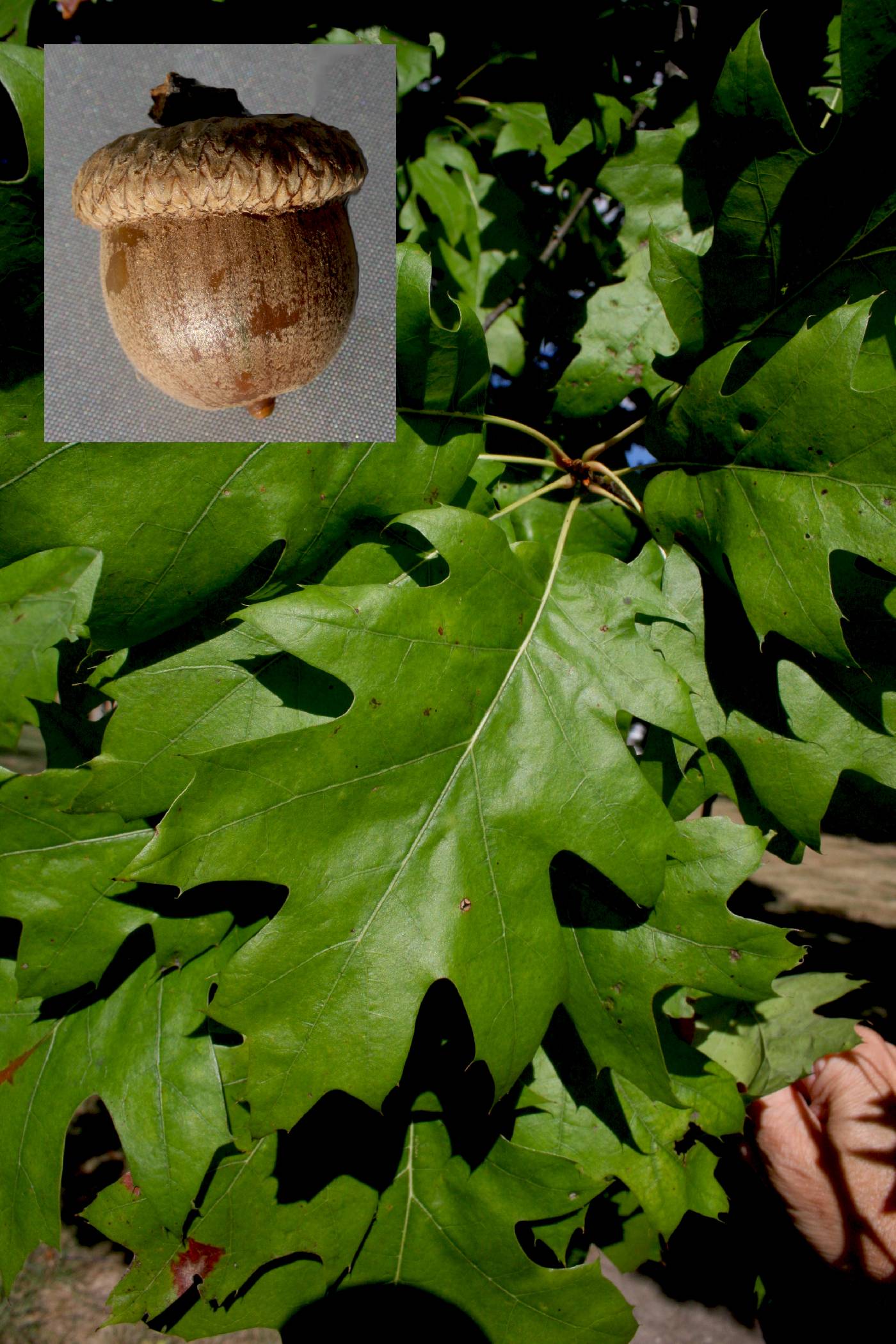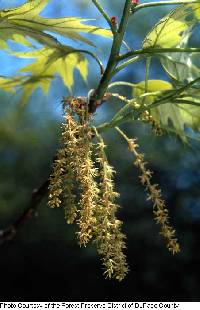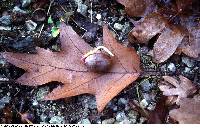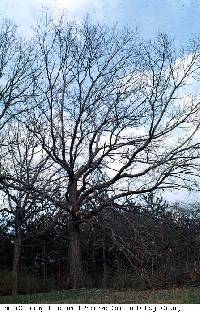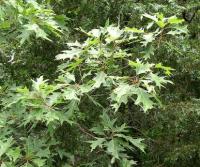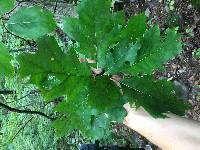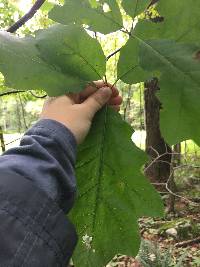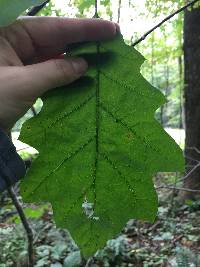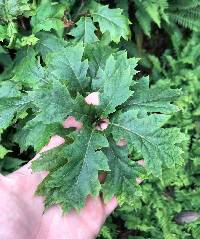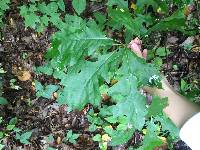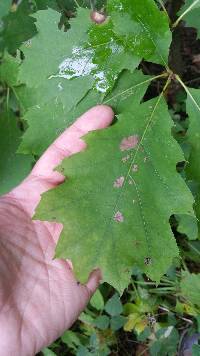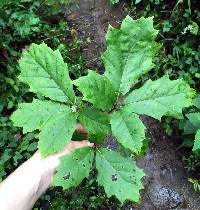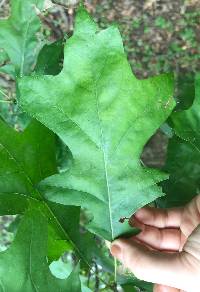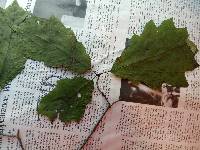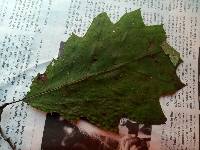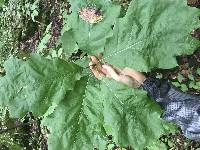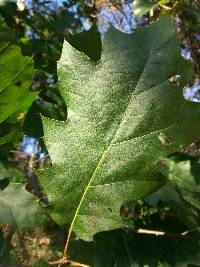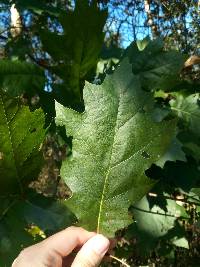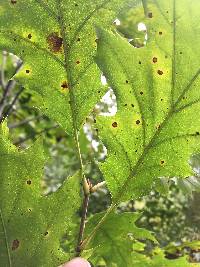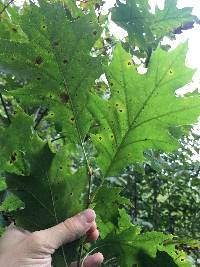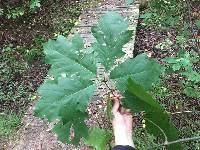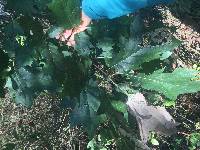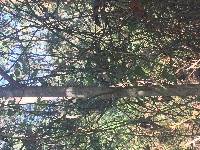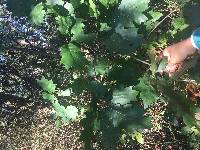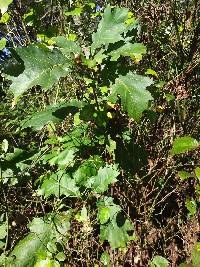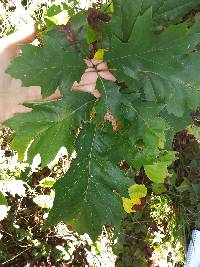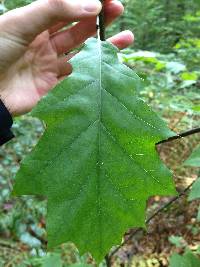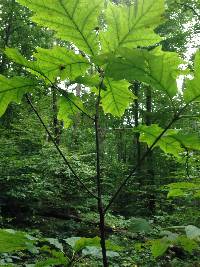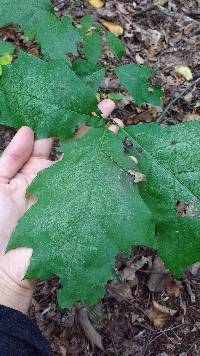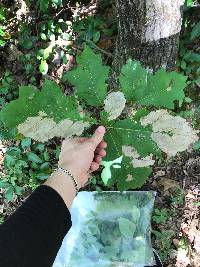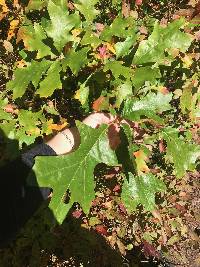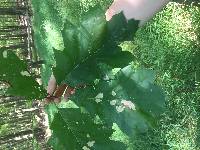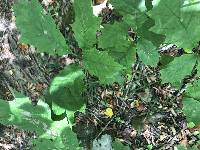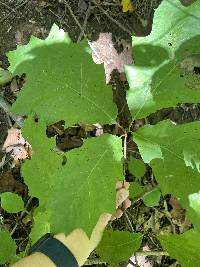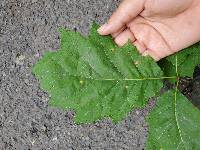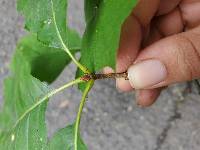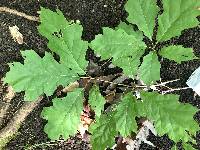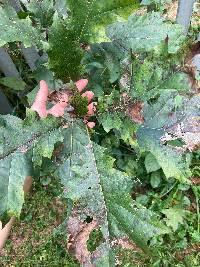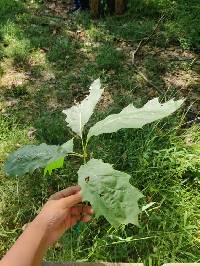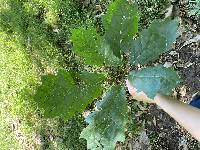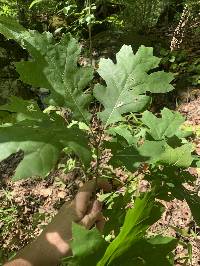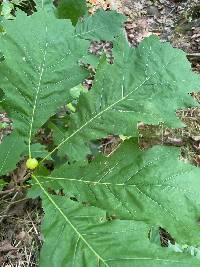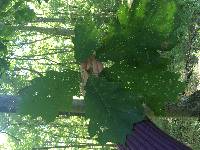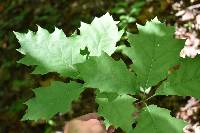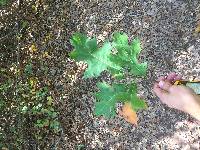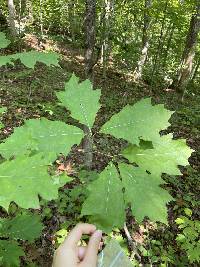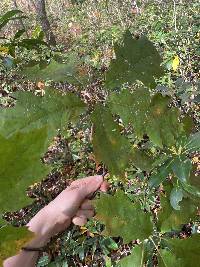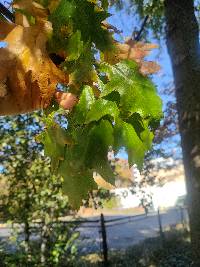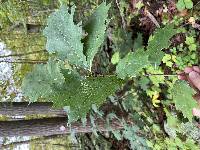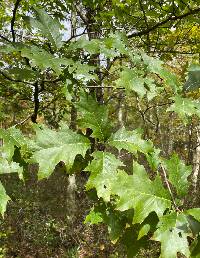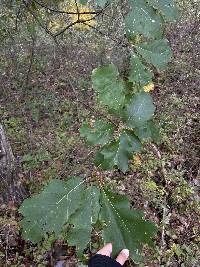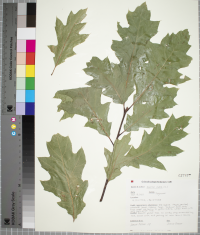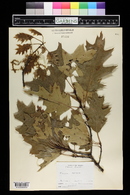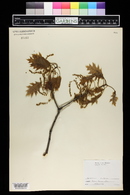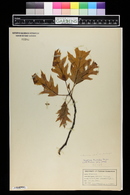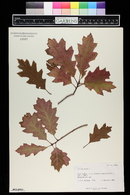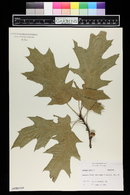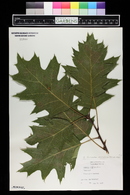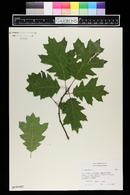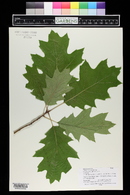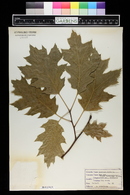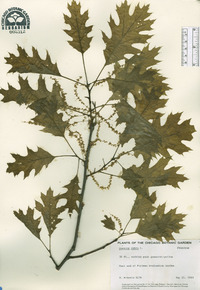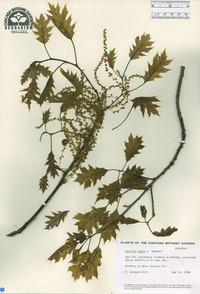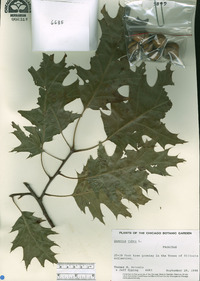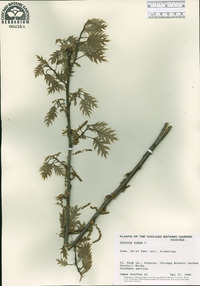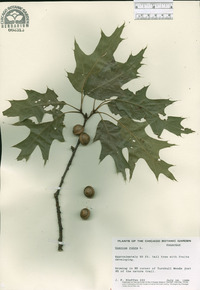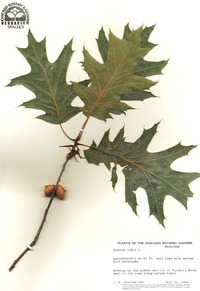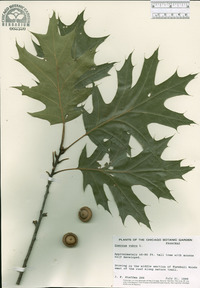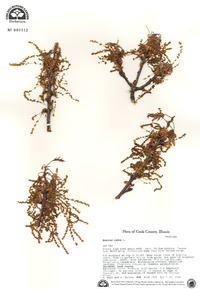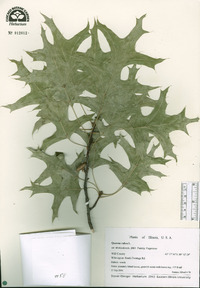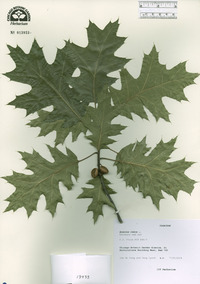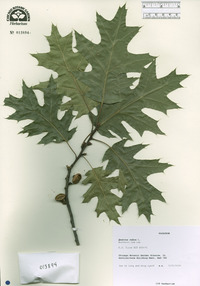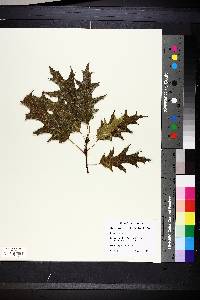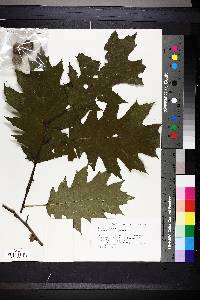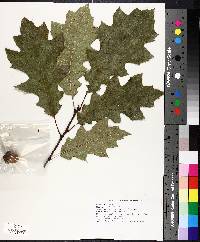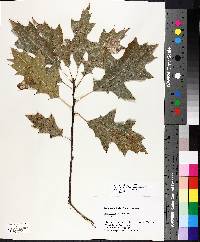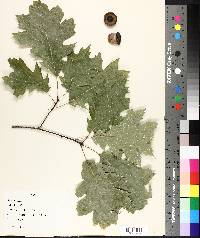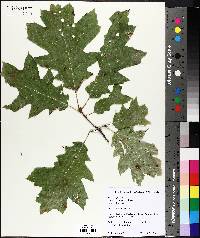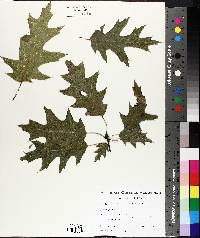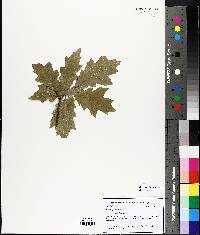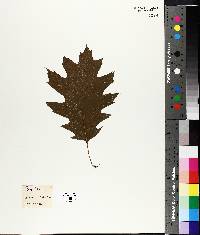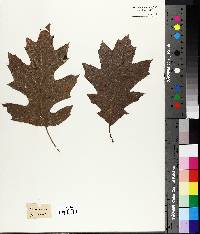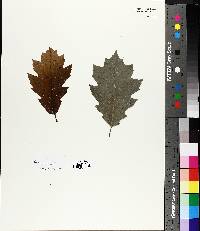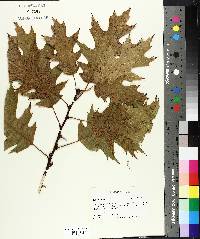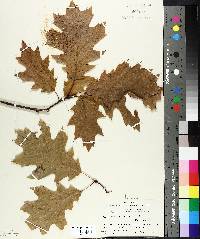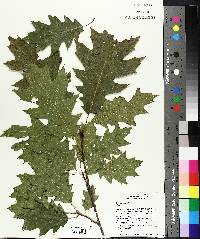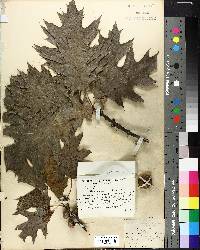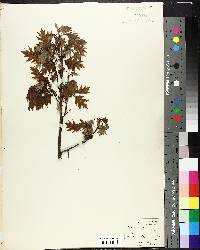Quercus rubra
|
|
|
|
Family: Fagaceae
Northern Red Oak
[Quercus borealis var. flabellata, moreQuercus rubra var. maxima Marshall, Quercus rubra var. ramosissima Marshall] |
Trees , deciduous, to 30 m. Bark gray or dark gray, ridges wide, shiny, separated by shallow fissures, inner bark pinkish. Twigs reddish brown, 2-3.5(-4.5) mm diam., glabrous. Terminal buds dark reddish brown, ovoid to ellipsoid, 4-7 mm, glabrous or with tuft of reddish hairs at apex. Leaves: petiole 25-50 mm, glabrous, often red tinged. Leaf blade ovate to elliptic or obovate, 120-200 × 60-120 mm, base broadly cuneate to almost truncate, margins with 7-11 lobes and 12-50 awns, lobes oblong, occasionally distally expanded, separated by shallow sinuses, sinuses usually extending less than 1/2 distance to midrib, apex acute; surfaces abaxially pale green, often glaucous, glabrous except for minute axillary tufts of tomentum, adaxially dull green, glabrous, secondary veins raised on both surfaces. Acorns biennial; cup saucer- to cup-shaped, 5-12 mm high × 18-30 mm wide, covering 1/4-1/3 nut, outer surface puberulent, inner surface light brown to red-brown, glabrous or with ring of pubescence around scar, scales less than 4 mm, often with dark margins, tips tightly appressed, obtuse; nut ovoid to oblong, 15-30 × 10-21 mm, glabrous, scar diam. 6.5-12.5 mm. 2 n = 24. Flowering spring. Commonly on mesic slopes and well-drained uplands, occasionally on dry slopes or poorly drained uplands; 0-1800 m; N.B., N.S., Ont., P.E.I., Que.; Ala., Ark., Conn., Del., D.C., Ga., Ill., Ind., Iowa, Kans., Ky., Maine, Md., Mass., Mich., Minn., Miss., Mo., Nebr., N.H., N.J., N.Y., N.C., Ohio, Okla., Pa., R.I., S.C., Tenn., Vt., Va., W.Va., Wis. Trees with large nuts only one-fourth covered by flat saucer-shaped cups often are treated as Quercus rubra var. rubra ; those with smaller nuts one-third covered by cup- or bowl-shaped cups are treated as Q . rubra var. borealis (F. Michaux) Farwell. While E. J. Palmer (1942) suggested that these two varieties do not breed true, K. M. McDougall and C. R. Parks (1986) found evidence of correspondence between morphologic types and flavonoid chemotypes. This is one of the most important ornamental and timber trees in the genus. Native Americans used Quercus rubra for a number of medical purposes, including the treatment of sores, weakness, lung problems, sore throat, dysentery, indigestion, chapped skin, chills and fevers, lost voice, asthma, cough, milky urine, hear trouble, blood diseases, and Italian itch, and as an appetizer (D. E. Moerman 1986). Quercus rubra reportedly hybridizes with Q . coccinea (= Q . × benderi Baenitz) and Q . ellipsoidalis (P. C. Swain 1972; R. J. Jensen et al. 1993); with Q . ilicifolia (= Q . × fernaldii Trelease), Q . imbricaria [ Q . × runcinata (A. de Candolle) Engelmann], and Q . marilandica (E. J. Palmer 1948; D. M. Hunt 1989); with Q . nigra (D. M. Hunt 1989); and with Q . palustris (= Q . × columnaris Laughlin), Q . phellos (= Q . × heterophylla F. Michaux), Q . shumardii (= Q . × riparia Laughlin), and Q . velutina (= Q . × hawkinsii Sudworth).
Tree 20 - 30 m tall, trunk 40 cm - 1 m in diameter Leaves: alternate, stalked, pink to red when opening, becoming dull dark green above and pale yellowish green to grayish beneath, 13 - 23 cm long, 9 - 15 cm wide, wedge-shaped to nearly square at base, five to eleven bristle-tipped lobes (usually seven to nine) separated by depressions reaching less than half way to the midvein, occasionally with tufts of hairs in vein axils. Leaves turn orange to red to brown in fall. Flowers: either male or female, found on the same tree (monoecious), greenish male flowers borne on hanging catkins 10 - 13 cm long, bright green female flowers borne near leaf axils. Fruit: an acorn, maturing in two seasons, solitary or in pairs. The stalkless or short-stalked cup is shallow saucer-shaped, covers just the base of the nut and has reddish brown, tightly appressed scales that are usually shiny with fine hairs. Nut reddish brown, 1.2 - 3 cm long, oblong. Bark: grayish brown and smooth, becoming dark gray to almost black with shallow fissures and flattened ridges, inner bark peach to pink. Twigs: changing from shiny green to reddish to dark brown. Buds: shiny reddish brown, 6 - 8 mm long, egg-shaped with a pointed tip, scales sometimes with reddish hairs at tip. Each terminal bud is surrounded by a cluster of lateral buds. Form: broad and rounded with large, wide-spreading branches. Similar species: Many species in the red oak group have highly variable, lobed leaves with bristle tips. Quercus velutina has leaves with depressions reaching half way to the midvein, inner bark that is bright yellow to orange, and fringed acorn cups that fit loosely and cover one-third to half the nut. The leaves of Quercus shumardii have depressions reaching three-quarters the distance to the midvein, the tufts of hairs at the leaf axils are very prominent, the buds are grayish to yellow, and the acorn cup is saucer-shaped and covers one-third of the nut. Quercus palustris has leaves with U-shaped depressions reaching three-quarters the distance to the midvein, dead branches remaining on the trunk, and a shallow acorn cup covering the base of the small nut. Quercus ellipsoidalis has leaves with depressions reaching three-quarters the distance to the midvein, dead branches remaining on the trunk, and an acorn cup enclosing up to half of the often elliptic nut. Quercus coccinea has leaves with C-shaped depressions reaching half the distance to the midvein, inner bark that is pink to red, and a reddish brown to orange acorn cup that covers one-third to half the nut, which has concentric rings at the tip. Flowering: May Habitat and ecology: Mesic to dry-mesic forests and old dune slopes. Occurence in the Chicago region: native Notes: Relatively fast growing, this species can be used in lawns, parks and other open areas. It is also an important lumber species. Quercus rubra naturally hybridizes with Q. palustris (Q. x columnaris), Q. velutina (Q. x hawkinsii), and Q. imbricaria (Q. x runciniata). Etymology: Quercus is the Latin name for oak. Rubra comes from the Latin word for red. Author: The Morton Arboretum Tree to 50 m; bark smoothish and with a reddish-purple cast until the trunk is 2-3 dm thick, eventually developing broad, shallow furrows between the narrow, flat, gray ridges; inner bark reddish or red-brown; young twigs glabrous, dark reddish-brown; lvs dull green, 10-20 cm, soon glabrous throughout or often with small tufts of persistent hairs on the vein-axils beneath, 7-11-lobed, the lobes roughly triangular, broadest at base, bristle-tipped and usually with a few lateral teeth, little if at all longer than the width of the central body of the blade; crown-lvs often more deeply cleft than the lower lvs as just described; acorn to 3 cm, its cup shallow, saucer-shaped, 2-3 cm wide and covering a fifth or a fourth of the nut, or sometimes the cup somewhat narrower and deeper and enclosing a third of the somewhat smaller (2-2.5 cm) nut; acorn-cup with a ring of hairs inside around the scar. N.S. and P.E.I. to Ga., w. to Minn. and Okla. (Q. borealis) Gleason, Henry A. & Cronquist, Arthur J. 1991. Manual of vascular plants of northeastern United States and adjacent Canada. lxxv + 910 pp. ©The New York Botanical Garden. All rights reserved. Used by permission. From Flora of Indiana (1940) by Charles C. Deam This oak is infrequent to frequent throughout the state and even common in some parts. It may be entirely absent from Benton, Newton, and possibly Lake Counties and is rare or absent in the Lower Wabash Valley. While our map shows no specimens from the southwestern part of the state, there are reports from that part and I have seen it growing there. The paucity of specimens of this and other species of oak is due to the fact that oaks do not produce fruit every year. To make a good specimen it is necessary to secure a branchlet that has grown in the sun with its leaves and mature fruit. This oak, in most of its area, grows on low ground but sometimes it is found on high ground with white and black oak and on the bluffs of streams. …… Indiana Coefficient of Conservatism: C = 4 Wetland Indicator Status: FACU Deam (1932): Wood hard, heavy, strong, close-grained, but not as good as white oak in any of its mechanical qualities. Commercially all of the biennial-fruited oaks are usually considered as red oak. The true red oak, however, is generally considered the best of all these. Until recently, when white oak became scarce, red oak was not much in demand, and was used principally for construction material. Now it is substituted in many places for white oak, and the uses now are in great measure the same as those of white oak. The red oak grows rapidly, and is able to adapt itself to many kinds of soils. It has been used in European countries for two centuries for shade and ornamental planting. It reproduces easily by planting the acorns, and should receive attention by wood lot owners as a suitable species for reinforcing woodlands, or for general forest planting. |
|
|
|

